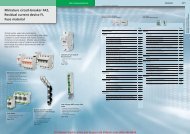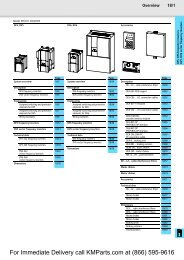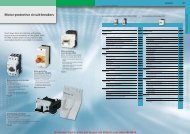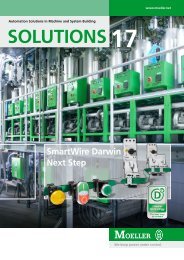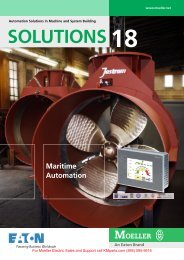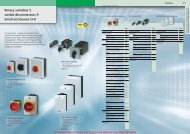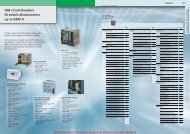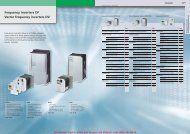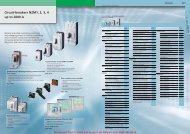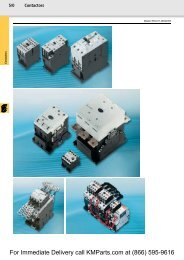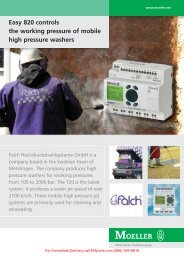Approvals and certificates - Moeller Electric Parts
Approvals and certificates - Moeller Electric Parts
Approvals and certificates - Moeller Electric Parts
Create successful ePaper yourself
Turn your PDF publications into a flip-book with our unique Google optimized e-Paper software.
<strong>Approvals</strong> for world markets<br />
Overview<br />
A1/3<br />
http://catalog.moeller.net<br />
<strong>Moeller</strong> HPL0211-2007/2008<br />
Selection of devices<br />
“Selection appropriate for export” does not mean<br />
merely meeting the requisite approvals <strong>and</strong> conformity<br />
to relevant specifications. The meaning of the term<br />
goes a great deal further by even including that<br />
equipment <strong>and</strong> installations must be designed to a<br />
concept with export in mind.<br />
The following are important criteria for selecting<br />
switchgear suitable for export:<br />
•For motor-protective circuit-breakers<br />
Use inherently short-circuit proof switches capable of<br />
controlling the highest prospective fault levels at the<br />
point of installation without the need for back-up<br />
protection.<br />
Advantage:<br />
– No restrictions whatsoever for installation<br />
– Complete independence from the on-site protective<br />
system<br />
– No problems getting spare parts<br />
•For circuit-breakers<br />
Use types with visible contacts, quick-make <strong>and</strong><br />
quick-break operation as st<strong>and</strong>ard. Use current-limiting<br />
circuit-breakers for high short-circuit levels. Selective<br />
switches are recommended for the selective<br />
graduation of networks.<br />
Advantage:<br />
– Independence from local accident prevention regulations<br />
requiring visible contacts, <strong>and</strong> safety fro<br />
faults caused by inexperienced operating personnel.<br />
– The effects of short-circuits are kept to a minimum.<br />
– Fuseless installations offer greater safety <strong>and</strong> reliability<br />
in plant operation. In the event of a fault, only<br />
the faulty section of the system is isolated.<br />
•For contactors<br />
Use contactors whose entire range provides consistently<br />
reliable operation in the event of voltage drops<br />
(80% U n should be aimed for) <strong>and</strong> whose contact system<br />
will not assume an indeterminate position either<br />
on closing or on opening in such conditions.<br />
Advantage:<br />
– During the electrification work in areas such as Africa<br />
<strong>and</strong> the Middle East, an insufficient voltage stability<br />
is – at least for a certain time – likely in many<br />
applications (for example due to long spur lines or<br />
small local generators). The use of devices that fullfill<br />
the above requirements will eliminate one of the<br />
maim failure causes related to contactors.<br />
•For enclosures<br />
Use insulated enclosures with transparent covers (i.e.<br />
“totally insulated” enclosures).<br />
Advantage:<br />
– Total insulation is the best possible protective measure<br />
from the user’s point of view, avoiding, reliance<br />
on the possibly doubtful skills of unknown installation<br />
personnel. Furthermore, protective measures<br />
based on earthing are often extremely difficult, if<br />
not impossible (in the Middle East, for example, due<br />
to the dryness of the ground).<br />
– Insulated enclosures completely eliminate the need<br />
for any additional protection against corrosion. The<br />
transparent covers contribute significantly to the<br />
correct operation of a system, because switchgear<br />
operation can be monitored even with the doors or<br />
covers closed, thus virtually eliminating the possibility<br />
of these being left open through carelessness.<br />
The transparent cover is an important contribution<br />
to safety, especially where exports to areas of uncertain<br />
skills are concerned.<br />
•For overcurrent protective devices<br />
Always use circuit-breakers <strong>and</strong> motor-protective circuit-breakers.<br />
Avoid fuses as far as possible.<br />
Advantage:<br />
– The operational reliability of a system is especially<br />
important for export contracts. Circuit-breakers <strong>and</strong><br />
motor-protective circuit-breakers provide this reliability<br />
in full measure since they can be immediately<br />
reclosed once a fault has been cleared, they disconnect<br />
all poles, they have ideal protection through<br />
high tripping accuracy <strong>and</strong> they can be used for selective<br />
operation. Because they have no fuses or<br />
other consumables, they also greatly reduce the<br />
problem of obtaining replacement parts. The advantages<br />
of fuseless design for export are especially<br />
evident in this case. No complicated investigation is<br />
needed to find out which fusing system is used in<br />
the respective location <strong>and</strong> which specifications<br />
have to be followed to select the correct fuses. Often<br />
several different fuse systems with widely varying<br />
characteristics are used side-by-side in the same<br />
country. For the uninitiated, it may be almost impossible<br />
to find the right fuse in these circumstances.<br />
These problems do not arise where a circuitbreaker<br />
is used.<br />
•For main switches <strong>and</strong> safety switches<br />
Use devices with positive contact separation <strong>and</strong><br />
clear switch position indication.<br />
Advantage:<br />
– The mechanical coupling of the actuating element<br />
with the contacts ensues that the Off position is indicated<br />
only when all main contacts are separated<br />
by the prescribed distance, <strong>and</strong> only in this position<br />
can the switch be padlocked. This ensures safety<br />
when carrying out maintenance <strong>and</strong> repair work on<br />
the installation or machinery.<br />
<strong>Approvals</strong> for world markets<br />
Test authorities<br />
<strong>Moeller</strong> devices have the approvals required for use in<br />
the following countries;<br />
For details a from Page A1/4<br />
USA<br />
UL<br />
Slovakia<br />
SK<br />
SKTC<br />
Shipping classifications<br />
<strong>Moeller</strong> devices have been approved by the following<br />
shipping classification societies:<br />
For details a from Page A1/8<br />
Germany<br />
Germanischer<br />
Lloyd<br />
GL<br />
Canada<br />
CDN<br />
CSA<br />
Pol<strong>and</strong><br />
PL<br />
BBJ-SEP<br />
United Kingdom<br />
Lloyd´s Register of<br />
Shipping<br />
LR<br />
France<br />
Bureau<br />
Veritas<br />
BV<br />
Romania<br />
RO<br />
ICECON<br />
ML PAT<br />
Turkey<br />
TR<br />
TSE<br />
Russia<br />
RUS<br />
GOST-R<br />
China<br />
PRC<br />
CCC<br />
Russia<br />
Russian Maritime<br />
Register of Shipping<br />
RS<br />
South Africa<br />
ZA<br />
SABS<br />
Ukraine<br />
UA<br />
Ukrain-GOST<br />
Italy<br />
Registro Italiano<br />
Navale<br />
RINA<br />
Norway<br />
Det Norske Veritas<br />
DNV<br />
Pol<strong>and</strong><br />
Polski Rejestr<br />
Statkow<br />
PRS<br />
For <strong>Moeller</strong> <strong>Electric</strong> Sales <strong>and</strong> Support call KMparts.com (866) 595-9616



